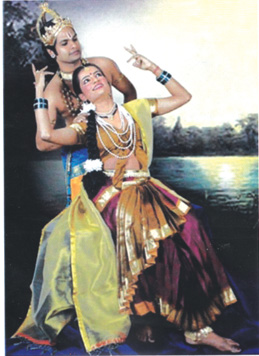|
 It all started with a phone call from Aravinth Kumarasamy, Managing and Creative Director, Apsaras Arts, Singapore, explaining to me the concept of his upcoming venture. He asked me if I could be the guest choreographer for Heroines of Raja Ravi Varma. The concept was exciting and I readily accepted. It was only much later that the magnitude of the production and the implication of my decision slowly dawned on me. I knew little about Raja Ravi Varma (1848-1906), the painter from the princely state of Travancore, who achieved recognition for his depiction of scenes from the epics like the Mahabharata and Ramayana. Besides, it would be no easy task to bring out the essence of his intense paintings through dance. The choreography had to be expressive, subtle and elegant – yet had to convey to the public the tales of Raja Ravi Varma's heroines. It all started with a phone call from Aravinth Kumarasamy, Managing and Creative Director, Apsaras Arts, Singapore, explaining to me the concept of his upcoming venture. He asked me if I could be the guest choreographer for Heroines of Raja Ravi Varma. The concept was exciting and I readily accepted. It was only much later that the magnitude of the production and the implication of my decision slowly dawned on me. I knew little about Raja Ravi Varma (1848-1906), the painter from the princely state of Travancore, who achieved recognition for his depiction of scenes from the epics like the Mahabharata and Ramayana. Besides, it would be no easy task to bring out the essence of his intense paintings through dance. The choreography had to be expressive, subtle and elegant – yet had to convey to the public the tales of Raja Ravi Varma's heroines.
In Singapore, I felt I had sprouted a dozen extra hands with the likes of Aravinth Kumarasamy and Neila Sathyalingam, Founder and Artistic Director of Apsaras Arts, who, with their kind, hospitable nature and reassuring words, made a molehill of the mountain in front of me.
The music for the production was almost ready by the time I came into the picture. Aravinth had chosen songs that would be apt to bring out the soul of the paintings. And we had with us some of Singapore's best dancers.
Raja Ravi Varma's paintings are possibly the best examples of the fusion of Indian traditions with the techniques of European art. The dance too was a blend of cultures and an amalgam of emotions.
The heroines we concentrated on were Seeta, Bhoomadevi, Damayanti, Radha, Sakuntala and Yasoda, as depicted in 14 well-known paintings by Ravi Varma. Known for their beauty, his heroines were personifications of passion, whose lives were filled with romance, love and tragedy. It was necessary to present the characters in a way the audience could understand and relate to the theme.
We first took up Bhoomadevi, a not-so-common theme in Bharatanatyam. The story of Bhoomadevi and Seeta had to be viewed as a conversation between a mother and a daughter and not as a far-fetched mythological tale. The story was about Seeta's anger, disappointment, rejection and resultant renunciation of her love for Lord Rama and her outpouring to her mother. This developed into an emotional scene. The final output had many in the audience in tears.
Next we worked on Ravi Varma's beautiful painting of Yasoda with baby Krishna. Pretending to be Yasoda and playing with young Madhumitha who played baby Krishna is something that is still close to my heart. The child was an absolute showstealer, playing her part with confidence and panache. We used compositions of Papanasam Sivan and Purandaradasa to convey the bond between mother and son. The simultaneous narration and depiction of emotions on stage, quite novel, vied with each other to capture the attention of the audience.
Our next heroine was Damayanti – it was the first time I was working on this theme. It was based on Ravi Varma's famous picture of the beautiful Damayanti and the golden swan. An interesting portion was when the swan teaches Damayanti to dance. This posed a challenge as both the characters were played by the same dancer. I must say it was Roshini Pillai's poise, elegance and grace and the complementing steps that made this part a visual treat.
Radha-Krishna is a common theme in Indian dance. I felt that as a choreographer I must think out of the box and present something unique and memorable. I must say Seema and Theepan did justice to their roles and touched many a heart. The production ended with a special tillana depicting the epic heroine Sakuntala, highlighting man's relationship with mother Nature.
I sat back and watched how the heroines of Raja Ravi Varma brought to life through the medium of dance, mesmerised by the intricate, breathtaking costumes, passionate and soulful dance and the overwhelming response of the audience comprising Indians, Chinese, Sri Lankans, Malaysians and Singaporeans. We hope to cast the same magic in Chennai one day. – (Courtesy: Sruti.)
(The author is a senior Bharata Natyam dancer, teacher and organiser, running Kala Pradarshini.)
|

